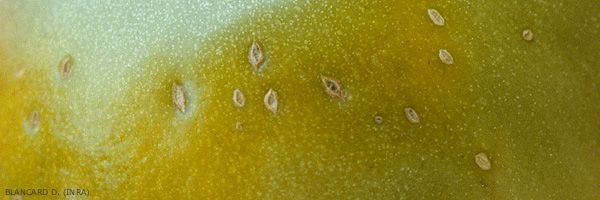
Fruit pox
( fruit pox, tomato pox )
( fruit pox, tomato pox )
Symptoms on fruits
Small whitish lesions, slightly elongated to oval, appearing in greater or less number on the epidermis in the stalk zone of tomato fruits. These changes spread slightly and become necrotic; the epidermis ends up splitting superficially (Figures 1 and 2).
This disease often has a very punctual expression in crops, on a few plants and a limited number of their fruits.
Origin of damage
Non-parasitic disease
Genetic anomaly transmissible to offspring affecting only certain varieties.
A few factors seem to influence the expression of this condition:
- high temperatures causing too rapid growth of plant vegetation and their fruits;
- limited vegetation which does not provide good fruit coverage.How to cure it
Once the damage has appeared, it is often too late to intervene. This anomaly is very dependent on the cultivar. We can still suggest the following tips.
The climate
Avoid excessively high temperature rises in shelters by ventilating and shading them in particular.
Ferti-irrigation
- Prevent sudden drops in the conductivity of the nutrient solution.
- Do not add too much nitrogen fertilizer and avoid low potassium levels.
The plant and its behavior
- Prevent sudden drops in the conductivity of the nutrient solution.
- Do not add too much nitrogen fertilizer and avoid low potassium levels.
The plant and its behavior
- Grow varieties that are not very sensitive.
- Promote optimal vegetation to best protect the fruits.
- Abandon the susceptible varieties during the next cultivation.
- Breeders should be careful when selecting new varieties not to use a parent susceptible to this genetic disorder.





